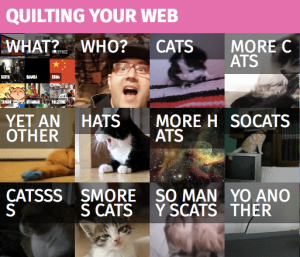Harvesting Air Quality Data with a NodeMCU, SensorWeb and IFTTT
Posted: July 13, 2016 Filed under: iot, mozilla, Uncategorized | Tags: arduino, ifttt, iot, mozilla 1 CommentProject SensorWeb is an experiment from the Connected Devices group at Mozilla in open publishing of environmental data. I am excited about this experiment because we’ve had some serious air quality discoveries in Portland recently – our air is possibly the worst in the USA, and bad enough that mega-activists like Erin Brockovich are getting involved.
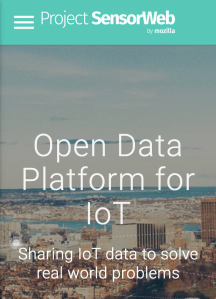
A couple of weeks ago, Eddie and Evan from Project SensorWeb helped me put together a NodeMCU board and a PM2.5 sensor so I could set up an air quality sensor in Portland to report to their network. They’re still setting up the project so I haven’t gotten the configuration info from them yet…
But you don’t need the SensorWeb server to get your sensor up and running and pushing data to your own server! I want a copy of the data for myself anyway, to be able to do my own visualizations and notifications. I can then forward the data on to SensorWeb.
So I started by flashing the current version of the SensorWeb code to the device, which is a Nodemcu 0.9 board with an ESP8266 wifi chip on board, and a PM2.5 sensor attached to it.

I used Kumar Rishav’s excellent step-by-step post to get through the process.
Some things I learned along the way:
- On Mac OS X you need a serial port driver in order for the Arduino IDE to detect the board.
- After much gnashing of teeth, I discovered that you can’t have the PM2.5 sensor plugged into the board when you flash it.
After getting the regular version flashed correctly, I tested with Kumar’s API key and device id, and confirmed it was reporting the data correctly to the SensorWeb server.
Now for the changes.
- I set up the Maker channel on IFTTT, which allows me post data to an HTTP endpoint to get it into IFTTT’s system.
- I then created a new IFTTT recipe that accepts the data from the device and pushes it into a Google spreadsheet.
- I forked the SensorWeb code and modified it to post to the Maker channel instead of the SensorWeb server.
I flashed the device and viola, it is publishing data to my spreadsheet.
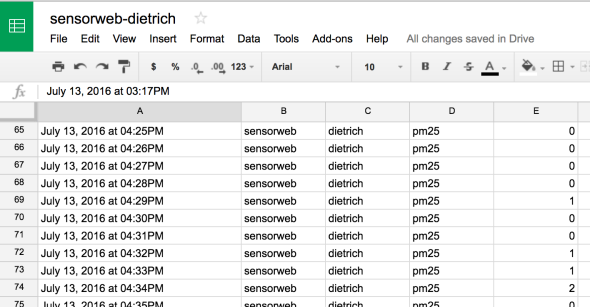
And now once SensorWeb is ready to take new devices, I can set up a new IFTTT recipe to forward the posts to them, allowing me to own my own data and also publish to the project!
Bubble and Tweak – IoT at the Ends of the Earth
Posted: July 12, 2016 Filed under: iot, mozilla, Uncategorized | Tags: anstruther, iot, mozilla, scotland 2 Comments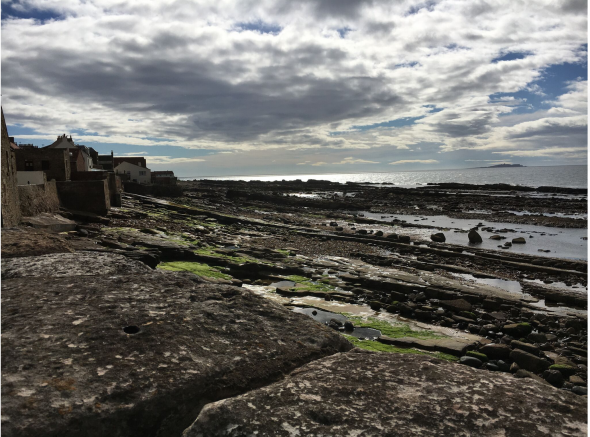
Last month I spent a week working on IoT projects with a group of 40 researchers, designers and coders… in Anstruther, a small fishing village in Scotland. Not a high-tech hub, but that was the point. We immersed ourselves in a small community with limited connectivity and interesting weather (and fantastic F&C) in order to explore how they use technology and how ubiquitous physical computing might be woven into their lives.
The ideamonsters behind this event were Michelle Thorne and Jon Rogers, who are putting on a series of these exploratory events around the world this year as part of the Mozilla Foundation’s Open IoT Studio. The two previous editions of this event were a train caravan in India and a fablab sprint in Berlin (which I also attended, and will write up as well. I SWEAR.).
Michelle and Jon will be writing a proper summary of the week as a whole, so I’m going to focus on the project my group built: Bubble.
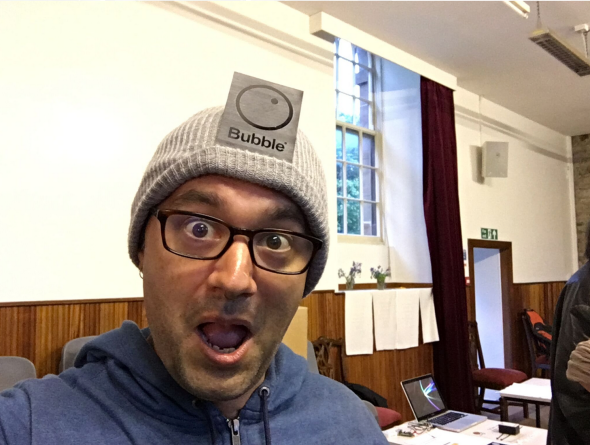
Context
From research conducted with local fishing folk, farmers from a bit inland, and a group of teenagers from the local school, we figured out a few things:
- Mobile connectivity is sparse and unreliable throughout the whole region. In this particular town, only about half the town had any service.
- The important information, places and things aren’t immediately obvious unless you know a local.
- Just like I was, growing up in a small town: The kids are just looking for something to do.
Initially we focused on the teens… fun things like virtual secret messaging at the red telephone boxes. Imagine you connect to the wifi at the phone box, and the captive portal is a web UI for leaving and receiving secret messages. Perhaps they’re only read once before dying, like a hyperlocal Snapchat. Perhaps the system is user-less, mediated only by secret combinations of emojis as keys. The street corner becomes the hangout, physically and digitally.
We meandered to public messaging from there, thinking about how there’s so much to learn and share about the physical space. What’s the story behind the messages to fairies that are being left in that phone box? I can see the island off the coast from here – what’s it called and what’s out there? Who the hell is Urquardt and what’s a “wynd”? Maybe we make a public message board as well – disconnected from the internet but connected to anything within view.
We kept going back to the physical space. We talked about a virtual graffiti wall, and then started exploring AR and ways of marking up the surroundings – the people, the history, the local pro-tip on which fish and chips shop is the best. But all of this available only to people in close physical proximity.
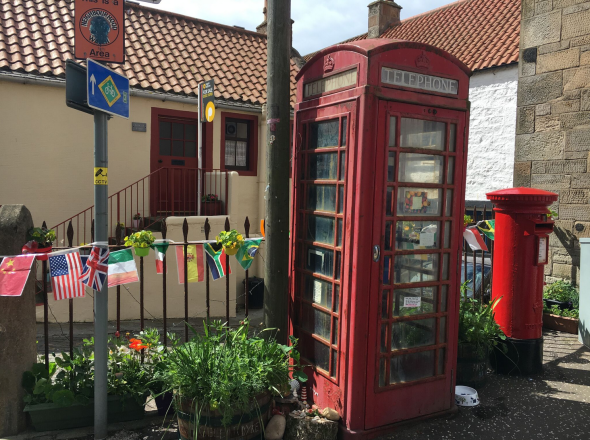
Implementation
Given the context and the constraints, as well as watching direction some of the other groups were going in, we started designing a general approach to bringing digital interactivity to disconnected spaces.
The first cut is Bubble: A wi-fi access point with a captive portal that opens a web page that displays an augmented reality view of your immediate surroundings, with messages overlaid on what you’re seeing:
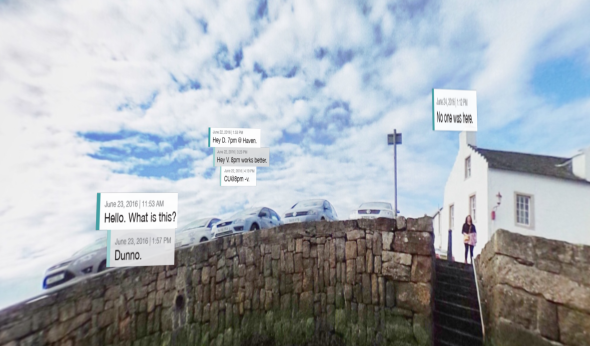
A few implementation notes:
- We used a Raspberry Pi 3, running as a wi-fi access point.
- It ran a node.js script that served up the captive portal web UI.
- The web UI used getUserMedia to access the device camera awe.js for the AR bits and A-Frame for a VR backup view on iOS.
- We designed a logo and descriptive text and then lasercut some plaques to put up where hotspots are.
Designs, board, battery and boxes:


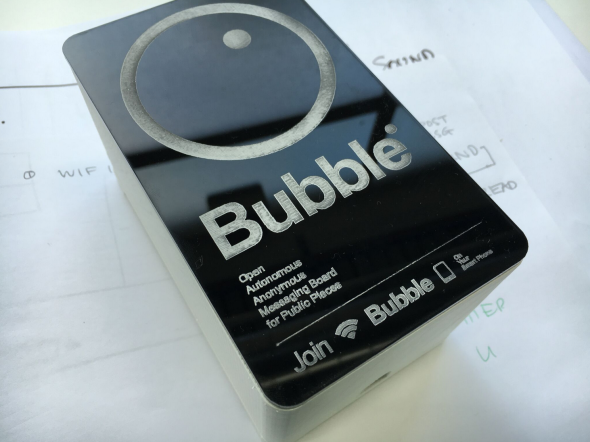
Challenges:
- Captive portals are hobbled web pages. You can’t do things like use getUserMedia to get access to the camera.
- iOS doesn’t have *any* way to let web pages access the camera.
- Power can be hard. We talked about solar and other ways of powering these.
- Gotta hope they don’t get nicked.
Bubble was an experimental prototype. There are no plans to work further on it at this time. If you’re interested, everything is on Github here. You can read more about the design here (PDF).
Thanks to fellow team members Julia Gratsova, Katie Caldwell, Vladan Joler. (Sadly, no Julia in the phonebox!)
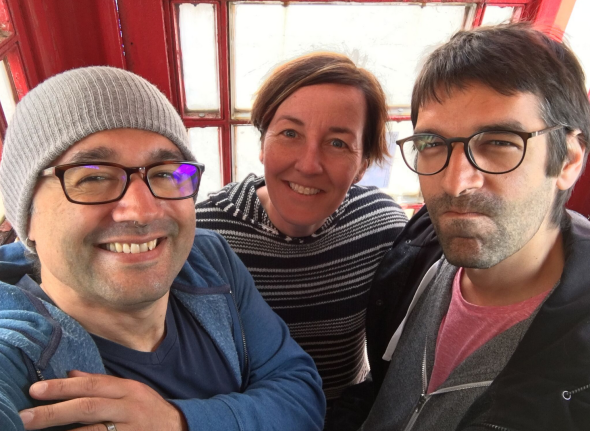
Remixable Quilts for the Web
Posted: December 18, 2014 Filed under: mozilla | Tags: mozilla, quilting, webdev, webmaker 1 CommentAtul Varma set up a quilt for MozCamp Asia 2012 which I thought was a fantastic tool for that type of event. It provided an engaging visualization, was collaboratively created, and allowed a quick and easy way to dive further into the details about the participating groups.
 I wanted to use it for a couple of projects, but the code was tied pretty closely to that specific content and layout.
I wanted to use it for a couple of projects, but the code was tied pretty closely to that specific content and layout.
This week I finally got around to moving the code over to Mozilla Webmaker, so it could be easily copied and remixed. I made a couple of changes:
- Update font to Open Sans
- Make it easy and clear how to re-theme the colors
- Allow arbitrary content in squares
The JS code is still a bit too complex for what’s needed, but it works on Webmaker now!
View my demo quilt. Hit the “remix” button to clone it and make your own.
The source for the core JS and CSS is at https://github.com/autonome/quilt.
Mozlandia – A Portland mini-guide for Mozillians
Posted: November 26, 2014 Filed under: Uncategorized | Tags: mozilla, mozlandia, pdx, portland Leave a commentAround 1,100 Mozillians will be in Portland next week. WELCOME!
Here is a list of things I recommend that you see, do, eat and drink and some handy tips. I’ve focused on places that are in or near downtown, though included some spots worth going out of your way for.
That said, downtown is not Portland. Well, obviously it’s part of it, duh. But it’s not overly representative of the Portland you’ve heard so much about. Get out of downtown for an evening or afternoon – and check out one of the neighborhoods. Nothing listed here is very far from downtown – Portland is pretty small.
I’ve left a LOT out. And forgot the rest. If you have recommendations, leave them in the comments.
UPDATE: Blue Star donuts, which are far more delicious but far less penis-shaped than Voodoo donuts, will be giving away free beignets on Friday Dec 5.
GENERAL TIPS
- Portland has no Uber or Uber-like services. If you have Car2Go in your city you can use that here too. Curb is the app for local taxi service through a couple of providers. You can get a bus to pretty much anywhere without too much of a wait. Ride the MAX and streetcar if you’re headed to areas that they service.
- Oregon has no sales tax. Do your Christmas shopping while you’re here.
- It gets dark around 16:30 – 17:00, so factor that into any plans for hikes, etc.
- If you go into the mountains, check the road conditions to see if you need chains for the car, or if the area is accessible at all.
- Go to Powell’s books. Go a few times. Then go back again. Check out the Science Fiction pillar there – how many have you read?
- Get high… for a good view of the city: Have a drink at Departures, dinner at Portland City Grill or visit Pittock Mansion for great views of the city. Even driving over the Fremont bridge (Highway 405) provides a spectacular view of downtown, the Willamette River and our many bridges.
- There aren’t a ton of restaurants/bars/coffeehouses that can hold large numbers of people. If you break up into groups of four (max), you’ll have a much better time and the servers, chefs, baristas and bartenders will like you for it.
- Be patient. Oregon is home to the slow-food movement in America. Regardless if this explains why your coffee took 20 f***ing minutes to make, it’ll make you feel better to think about that. See also the above note about small group sizes to mitigate the waits.
- Tipping: I tip a dollar for a good coffee. I generally tip ~20% for any kind of sit-down meal. But I also worked as a barista, server and chef before getting into tech, so I’m biased towards tipping 😉
CARTS – Just the 9th & Alder pod for the purposes of this post. If you’re from California – up here they are not “food trucks”, they are “food carts”… even when they are trucks.
- Hoang’s – Get soup #17.
- Nong’s khao man gai – Simple and good and oddly famous.
- Wolf & Bear – Israeli street food that is amazing. And vegan.
- Güero – Excellent tortas. Add an egg.
- La Jarochita 2 – Great Mexican cart. The only Mexican cart (aside from Güero) worth going to at the 9th and Alder cart pod.
- Brunch Box – A cart that graduated to a proper storefront, but is right by the 9th and Alder carts. Great egg sandwiches for breakfast (try the Black and Blue) and terribly good burgers the rest of time. Very fast.
- Kargi Gogo – Georgian food. The country, not the American state. Irakli says it’s legit too.
DRINK
- Multnomah Whiskey Library
- Clyde Common
- Pepe le Moko
- Teardrop
- Bailey’s Taproom
COFFEE
- Courier – They also make fresh canneles daily.
- Heart – Excellent coffee.
- Barista
- Coffeehouse Northwest
- Stumptown
- Case Study
- Coava – Not downtown but my favorite coffee roaster in town.
- Ristretto – Not downtown, but fantastic coffee in beautiful spaces. The Nicolai location is especially great – check out the custom metalwork and crazy woodwork, and visit Schoolhouse Electric in the same space.
EAT – I’ve only noted a few of my go-to places, or those that are near where Mozillians are staying, or open late, etc. I’ve got a somewhat-up-to-date list here with more recommendations, but there’s just really too much to cover. Go out and explore.
- Clyde Common – Always interesting menu, good whiskey selection, great cocktails. Fries + harissa and a cocktail is a great way to end your day and start your evening.
- Tasty and Alder (downtown) – Shared plates, everything is good.
- Luc Lac – Vietnamese + cocktails, serves food VERY late, and closest place worth going to that’s also near the Waterfront Marriot.
- Bunk – Excellent sandwiches.
- Lardo – Excellent sandwiches as well.
- Racion – Amazing cocktails and fun Spanish-tinged molecular gastronomy.
- Little Big Burger – Fast and good late night burger.
- Not downtown, but places I always want to go back to…
- Biwa – Izakaya, open late, always amazing. Burger served only after 11pm.
- Tarad – Northern Thai food, open late. Pok Pok gets all the attention but after living in northern Thailand, this is where we go for the real thing.
- Mee Sen – Another good Northern Thai food spot we go to.
- Podnah’s BBQ – Worth heading up into NE Portland for.
- La Taq – Next door to Podnah’s, fantastic Mexican bar food.
- Sweedeedee – Most likely to feel like you’re in Portlandia at this spot. Amazing house-baked breads. Tiny. Expect a long wait but good people watching and excellent food.
- Por Que No (Mississippi location) – Great tacos.
- Ha & VL – Get the special soup of the day, whatever it is.
NEIGHBORHOODS – Places to walk, eat, drink, shop and experience parts of Portland that are far more interesting than downtown.
- Alberta St – Between NE 15th Ave and NE 31st Ave
- Belmont St – A few blocks on either side of SE Belmont and SE 34th
- Division St – Between SE 30th and SE 39th
- East Burnside – From NE Grand Ave to NE 12th Ave and then up and down NE 28th and Burnside
- Hawthorne Blvd – Between SE 32nd Ave and SE 49th Ave
- N Mississippi Ave – Between N Fremont Ave and N Skidmore Ave
- NW 23rd Ave – Between W Burnside and NW Thurman Ave
- NE Williams Ave – Between NE Fremont Ave and NE Skidmore Ave
EXCURSIONS
- Columbia Gorge – See Multnomah Falls, the view from Vista House, climb Beacon Rock, stop at the Bonneville Dam and see Herman the Sturgeon, drive across the Bridge of the Gods (and back), then go for lunch at one of the Hood River breweries. Some easy/moderate 1-2 hour hikes I like: Angel’s Rest, the Multnomah/Wahkeena Falls loop, Triple Falls, Horsetail Falls, Punchbowl Falls, all listed here.
- Mount Hood – Drive out Highway 26 to the historic Timberline Lodge with amazing views of Mt Hood (if it’s clear), then down to Hood River and head home through the Columbia Gorge on Hwy 84.
- Mount St Helens – A couple of hours north, but the view of the blast zone and crater from the visitor center on the NW side is well worth it if the view is clear. On the SE side you can hike one mile underground through Ape Cave, and check out the amazing rock formations and brave the cable bridge at Lava Canyon.
- Oregon Coast – About two hours drive. Walk the promenade at Seaside, get ice cream at Tillamook, watch storms from the tip of Oregon at the mouth of the Columbia river.
Firefox OS: Devices and Dark Matter
Posted: January 15, 2013 Filed under: firefox, firefox os, mozilla | Tags: Boot2Gecko, Firefox OS, mozilla 24 CommentsUPDATE: Scroll down for update on May 26, 2013.
Since beginning work on the Firefox OS project, the number one question I’m asked is “Does it run on my phone?”. Sadly, the answer for almost everyone is “no”. The question itself is interesting though, and shows how people – even geeky technical people – don’t have a good understanding of how mobile devices work, nor the whole business and technical ecosystem that brings these things into the hands of consumers (hm, maybe that’ll be my next blog post). Porting an operating system to a device is tricky work in the best of circumstances and when done without the direct assistance of the various business entities involved in the stack for any single device (OEM, chipset manufacturer, original OS vendor), involves a lot of, well, fiddling around. The kind of fiddling around that voids warranties and turns $600 hardware into a paperweight. The success and hackability of Android simplified things a lot, creating a relatively large community of people doing OS-to-device porting, and enabling a lot of what allowed Firefox OS to bootstrap so quickly. However, it’s still not easy.
I was curious about who is playing around with Firefox OS in the dark corners of the Mos Eisley of the device-porting porting world,the XDA-Developers forums. Below, I’ve listed a number of threads involving efforts to port Firefox OS to various devices. Some have builds, some are aborted attempts, but the totality shows the level of interest in putting a truly open Web operating system on low-powered commodity mobile hardware that is very exciting.
Oh, and if you’re interested in porting Firefox OS to your device, the basic instructions to get started are on the MDN B2G Porting Guide. If you scan any of the threads below or have ever tried doing this kind of work before, you already know: Thar be dragons. You could lose your device and your sanity, and will very likely void the warranty. Consider yourself warned.
- Samsung Epic 4G Touch, Samsung d710 (and some code on Github)
- HTC Wildfire S
- HTC Sensation – Some talk of debugging the porting process, and links to other ports such as Razr, Ascend g300.
- Samsung Galaxy Gio
- HTC Jewel (EVO + LTE)
- Samsung Galaxy Nexus
- LG Optimus 2X
- Samsung Nexus S & Nexus S 4G – thread 1, thread 2
- HTC Dream/G1 (old skool!)
- Samsung Galaxy S III
There are also some efforts at porting to other types of devices, such as Oleg Romashin’s experiments with Firefox on Raspberry Pi, MDN instructions for building for Pandaboard, and a bug for some core changes to Firefox OS to ease porting to basic Linux systems like Beagleboard and Chromebox.
UPDATE May 26, 2013
New devices since this was originally posted, and some fantastic updates:
- Raspberry Pi! Philipp Wagner, a student from Germany, updated Oleg Romashkin’s porting work, and wrote the Raspberry Pi for Firefox OS guide, where you can download builds and read instructions for building it yourself. I installed his build and was up and running on my Raspberry Pi in minutes. Check out his blog post, and buy him something from his Amazon wishlist 🙂
- As I’m sure you’ve heard by now, Geeksphone has two devices available with Firefox OS pre-installed now available for purchase. The devices keep selling out FAST, so keep a watch on their Twitter account. Also, according to their forums they’re going to make nightly updates available over-the-air soon, so you can stay on the latest versions of Firefox OS.
- At this year’s Mobile World Congress, Sony released ROMs for the Experia E.
- The XDA-Developers blog reported on a Firefox OS port for the HTC HD2.
- Also on the XDA-Developers blog was a port for the HTC Explorer (aka Pico).
- You can find build instructions for running Firefox OS on Pandaboard up on the Mozilla Developer Network.
A couple of other notes:
- XDA-Developers now has a Firefox OS forum, where there are lots of threads on the porting process, individual devices, and app development.
- All XDA-Developers blog posts tagged Firefox OS.
Firefox 11 is Smaller and Faster
Posted: March 14, 2012 Filed under: firefox, mozilla | Tags: firefox, memshrink, mozilla, Performance, snappy 12 CommentsWe quietly shipped Firefox 11 with a bunch of performance fixes that both reduce the amount of memory that Firefox uses, and improve the responsiveness of it’s user interface.
These types of changes are not easy to talk about. Often they’re very technical, and meaningless to anyone but the developers involved, which is probably why we usually don’t enumerate them in the the release notes or other public announcements. “Firefox is 74% faster when you open menu X, and twice as fast in some garbage collection scenarios!” Yeah, not an eye-popping headline. We could do a lot better in communicating these improvements in broadly meaningful ways though – nice graphs or some competitive site like arewefastyet would help a lot. But until then, here’s a short summary of the improvements in Firefox 11. And if you know of other performance fixes that don’t fall into the categories below, please add them in the comments!
Memory Use (aka “memshrink”)
The Memshrink project has been going for quite a while now, led by Nicholas Nethercote. He blogs weekly updates on the project’s activity. According to Bugzilla, there were 29 memshrink bugs marked fixed during the Firefox 11 development cycle – four of which were P1, or very high priority. Some of the fixes were related to tools and detection methods, but many are actual reductions in memory use. The changes that made it into Firefox 11 include fixes for detected leaks, removing of zombie compartments, lazy-loading data, reducing the size of some caches, reducing memory used while scrolling, and many more.
UI Responsiveness (aka “snappy”)
The Snappy project started last December, and is run by Taras Glek. Its aim is to improve the responsiveness of the Firefox UI. Taras has been posting weekly updates on Snappy activity on his blog. Bugzilla shows 15 snappy bugs marked fixed during the Firefox 11 development cycle. The project had just started, but there are still some significant wins in this release! Firefox 11 includes reductions in queries in the bookmarks system, reduced preference lookups, faster data collection for session restore, and various improvements in the DOM code.
Add-on Compatibility
While it’s not related to performance, I do want to call attention to something that many people don’t seem to know: In Firefox 10 (yes, the previous release) we stopped marking most add-ons incompatible when you upgrade. That means that a LOT more of your add-ons will continue to work when you upgrade Firefox from here on out. The only add-ons that still require compatibility bumps are those that have binary components, since they need to be recompiled against the current version.
Browser Services Update (TGIF)
Posted: March 2, 2012 Filed under: firefox, mozilla | Tags: firefox, mozilla 2 CommentsMy team is “a riddle, wrapped in a mystery, inside an enigma”. Ok, maybe not *that* mysterious, but we’re definitely involved in a variety of projects. Here’s a roll-up of a week in browser-land.
Performance
- Tim landed a patch that adds reporting of leaked windows and documents to our unit test runs. Dao’s work has shown that these often reflect leaks in the platform not just the test, so it’s very valuable to know about them. The next step is to track the leak numbers between runs and report regressions by making the tree color change somehow. Tim also blogged about this.
- Neil has a patch up for adding telemetry that measures how long it takes to open a browser window.
- Mano continued his work on the Safari migrator, which includes various cross-migrator improvements. This work is part of a broader rewrite of the migrators to use Places async APIs, for improved responsiveness.
- Marco landed a major rewrite of Livemarks, converting them to load content on-demand and asynchronously, reducing synchronous IO on the main thread.
- Paolo continued his work on rewriting favicon API consumers to use the new asynchronous API.
- Drew has completed the conversion of the content preferences service to use async mozStorage statements, and is in the process of updating the various JS and C++ consumers to use the new API.
- I talked a bit with Mark Cote about Peptest, a new framework for testing browser responsiveness. Peptest is currently available on the tryserver, but results are highly variable, so there’s more work to do before it can be turned on for all check-ins. Once Peptest is ready to use, we’ll evangelize the crap out of it.
- I continued working on breaking apart the session restore service into more manageable pieces (XPath generator, tab state, form data).
- I put up a WIP patch for reading the session file asynchronously during startup.
- I started working on measuring how much time is taken up by creating about:blank browsers when restoring sessions on demand.
New Tab Page
- Tim worked on Stephen Horlander’s redesign of the new-tab page, and also fixed some bugs.
New Download Manager
- Paolo consolidated existing patches into a single one for final pass and check-in. Marco has been reviewing.
- Paolo and Marco are getting together in Novara on Saturday to sprint on fixing theme bugs and other cleanup required for landing.
Add-on SDK Integration
- Met with Irakli to create plan for landing the core SDK modules in Firefox so that the whole SDK would no longer need to be bundled with every add-on.
- Created a feature page for tracking the project.
- I talked with Brian Warner about syncing Git repos with HG repos.
Web Apps Integration
- I updated the feature page with latest from UX, Apps and PM.
- Felipe Gomes is driving the Firefox side of the integration work, with Tim helping out on UI. They’re working together with Fabrice, Myk, Dan and Tim A.
Identity Integration
- David has the window.crypto.getRandomValues patch up for final review and superreview.
- David put up an initial patch for the navigator.id API for Web content.
- David gets to play with NSS+DOM+XPCOM to get DOMCrypt’s internal API working. Lucky guy.
Share Integration
- David is working with Shane Caraveo to get the new Share add-on reviewed and landed.
Evangelism/Engagement
- Tim and Marco kicked off sponsorship process for Italy’s jsDay conference. They’ll be putting up a booth there, along with Paolo Amadini, representing Mozilla. Thanks to Stormy and Shez for the support from Developer Engagement.
Of course, we all worked on various other things as well, from code review to bug triage to random maintenance fixes. Activity logs and whatnot are listed below.
- David Dahl: Bugzilla activity log, status updates, blog, Twitter
- Drew Willcoxon: Bugzilla activity log, status updates
- Felipe Gomes: Bugzilla activity log, status updates, blog, Twitter
- Asaf Romano: Bugzilla activity log
- Marco Bonardo: Bugzilla activity log, status updates, blog, Twitter
- Neil Deakin: Bugzilla activity log, status updates, blog
- Paolo Amadini: Bugzilla activity log
- Tim Taubert: Bugzilla activity log, status updates, blog, Twitter
- Dietrich Ayala: Bugzilla activity log, status updates, blog, Twitter
Brussels: Warm Hospitality Amidst Inhuman Conditions
Posted: February 3, 2012 Filed under: firefox, mozilla | Tags: belgium, brussels, coworking, firefox, hackerspace, mozilla 2 CommentsWe’re at the end of our Performance work-week here in Brussels, and gearing up for a two-day orgy of European open-source culture at FOSDEM. I’ve successfully acquired a cold (and hopefully not worse) due to the temperature being consistently below freezing.
However, the people here in Brussels have made up for their weather shortcomings by welcoming us wherever we go. Between the hackerspaces and co-working spaces, and the restaurants that happily take large groups with little or no notice, I’m very impressed!
HSBXL
The hackerspace in Brussels is located in Schaerbeek, a neighborhood to the north of the city center. The space used to be a vehicle repair garage for the city, but was given up for use by the geeks. They’ve installed serious hardware, and have fully-equipped the place with everything needed for survival. Thanks to Rafael and Patrick, for answering all our questions and helping us make mate and to find food nearby. Lunch on the second day was described by Patrick as a “little French place”, but turned out to be a hall of worship dedicated to Tintin!
Faubourg St Antoine is filled with Tintin toys, art and knick-knacks, including some alternate interpretations and even a clarification for something I’d always wondered about. Sadly, they’ve been issued a legal notice from the current copyright (or EU equivalent) holders requiring them to remove all the Tintin materials from public display 😦
BetaGroup Coworking
Once the temperatures dropped far below freezing, we relocated to BetaGroup Coworking Brussels in Etterbeek, to the southeast of the center. Ramon Suarez, the manager of the space was very accommodating, taking us on short notice. The wi-fi was blazing fast, the coffee was hot, and the ping-pong was a welcome break from heads-down hackery. The space itself was fantastic, with a great combination of quiet co-working areas, public spaces and private meeting offices. With tons of natural light, steel bridges and a meeting space on what looked like a submarine conning tower, it was truly impressive.
We had a wonderful lunch at a very tidy restaurant nearby.
Overall, it’s been a fun and productive week, if a bit chilly. Like, really chilly. Ridiculously so. Why do people even inhabit places that get this cold? Honestly, wtf.
Firefox Performance Work-week & FOSDEM
Posted: January 30, 2012 Filed under: firefox, mozilla | Tags: belgium, brussels, firefox, hackerspace, hackerspaces, mozilla, Performance 1 CommentThe Performance team and some of the Firefox team are spending the week in Brussels, laying waste to some of the performance issues in the browser.
Much thanks to our excellent hosts HSBXL, a hackerspace in central Brussels. We’re equipped with fast internet, lemon soda, mate, techno music, and of course beer.
Following the work week is FOSDEM, Europe’s biggest open source conference. If you’re in town for FOSDEM and want to come hack with us, ping me on twitter or join us in #perf on IRC.
I’ll be uploading pics to flickr with the tag ‘perfworkweek2012’.
Unbookmarking the Future of Browsing
Posted: January 26, 2012 Filed under: firefox, mozilla | Tags: Add-ons, browsing, firefox, jetpack, mozilla, panorama 31 CommentsI am needy:
- I want to remember URLs. Bookmarking is too manual and akin to throwing URLs in the sarlacc pit. The user-interface pieces around bookmarking have not changed in a decade. No, the awesomebar is not a good tool for this. I don’t even come close to being able to recall what I want the awesomebar to recall. I need to be ambiently prompted in a way that is visual and has context.
- I need to be able to focus on a given task, project or idea. A single sea of tabs doesn’t help at all. I want blinders. I want an environment. Task immersion.
- I need to be able to categorize URLs into groups, such that the whole group is easily accessible. Trees and menus can go to hell, along with the RSI, eye-strain and visual boredom they provide.
- I need to be able to switch contexts quickly and easily. Eg: From bug triage to perf to dashboards to music, etc.
- I don’t want to leave the browser. Windows are super heavyweight feeling and come along with all kinds of operating system baggage: visual, interaction, performance, etc.
I realized recently that a pattern had emerged in my browser usage that meets a bunch of these needs:
- I use Firefox’s Panorama feature to manage groups of tabs. I have groups for a bunch of work areas, and for Food, Music, Design, JavaScript, Health, and many more. This provides task-specific browser contexts, as well as keyboard shortcuts for switching contexts with ease.
- I set up Firefox to restore my session every time it starts. This way my groups persist, and all the URLs in each group are loaded with their cookies and other session data ready to go when I need them.
- I have “Don’t load tabs until selected” checked, so that Firefox does all this with as little memory as possible – the web pages in all the tabs in all the groups aren’t loaded until I actually use them.
- I restart the browser a couple of times per day to keep memory use slim, which in turn keeps the browser responsive. Restarting is super fast and responsive because I have “Don’t load tabs until selected” (see previous point).
This is the happiest I’ve been with any browser in years. However, there are still a bunch of pain points. I want SO much more.
- I want to tag URLs without bookmarking them. The bookmark concept just gets in the way. It’s an unnecessary unit of psychological weight. It’s a vestigial metaphor of days gone by.
- I want to open a tab group by typing the name of the group in the URL bar.
- I want to add URLs to multiple groups easily, similar to tagging. I’d like to do it via the keyboard.
- I want to send the current tab to a different group (or groups) using only the keyboard.
- I want app tabs that are specific to a given group, and some that are global.
- I want to switch quickly from an app tab back to the last non-app tab I was at. Or be able to peek quickly at an app tab without losing my context in the current set of tabs.
- I want to switch quickly back to the last tab I was at. (Eg: When I open a new tab, and get sent to the end of the current set of tabs). OR be able to have new tabs open immediately to the right of the current tab, with linked parentage.
- I’m tired of sites being browsers inside a browser. And I don’t want “site-specific” browsers – I want a “me-specific” browser, for local or dynamic content.
- Firefox creates the <tab> elements for hidden tabs when restoring the session. It would re/start even faster and use even less memory if the XUL elements for hidden tabs were not created until the group itself was opened.
- As I work, memory use increases and responsiveness decreases, since I keep visiting more and more tabs. If I haven’t visited a tab in a while, Firefox should unload it. If I haven’t visited a group in a while, Firefox should completely unload the whole group, session content *and* XUL elements.
- A downside of the “Don’t load tabs until selected” option is that tab content is not ready and waiting when you select the tab. The web content has to load and the session data for the tab must be restored. Firefox should pre-load tabs that are adjacent to the active tab. This feature, combined with the dormant-izing of tabs described above would result in a decent balance of instant-gratification availability and responsiveness and resource frugality.
One idea I had was a merging of tagging and groups: The groups in Panorama would be comprised of the set of tags that exist. This would result in nice integration bits like search-by-tag in the awesomebar being equivalent to search-in-group. It also might mean that we’ll need to make Panorama “bigger” – maybe allow it to be zoomed, or make it an infinite canvas.
An idea for navigating dynamic content is to merge feeds and groups. Imagine you have a BBC group, which has the BBC feed as it’s source. The set of “tabs” in that group are the items in the feed. If you open the group, all the URLs in the feed are loaded into tabs (but not *really* loaded if you restore-on-demand).
Anyways, it’s interesting to think about how to prototype some of these ideas in an add-on or a collection of them. I’m sure some of the items above already exist as add-ons.
I realize that I’m not a “typical user”. However, after almost 6 years of browser-making, I’m pretty damn sure that there is no such person. I do not believe that the one-size-fits-all browser is the future. When adding a feature or fixing a bug, we shouldn’t have to choose between grandma and the geeks. In order to stay relevant in a highly-personalized future, we should strive to ensure that Firefox is pliable enough that we who make it are not restricted by it, and more importantly we must ensure that add-on developers are free to mash-up and remix and experiment the f*ck out of it.

